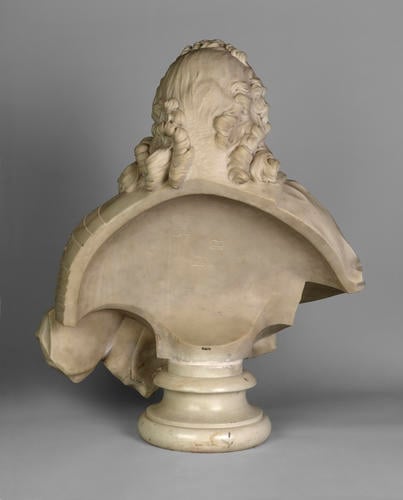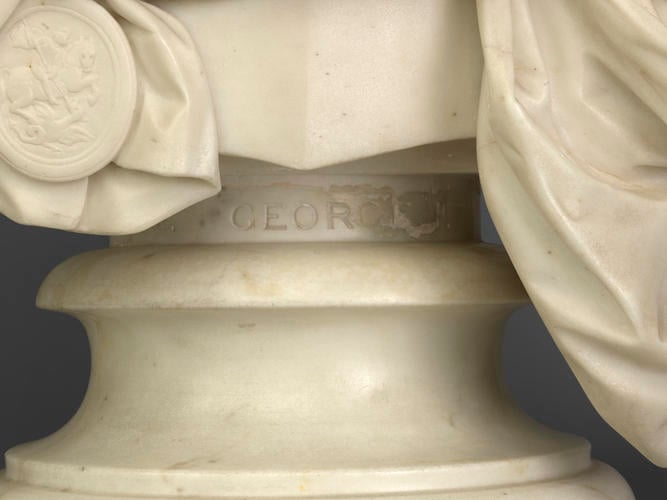-
1 of 253523 objects
George II (1683-1760) 1757-63
Marble | 77.8 x 60.0 x 31.0 cm (whole object) | RCIN 31614
-
A life-size white marble bust of George II, wearing armour which is partly covered with drapery. The head is slightly raised and turned fractionally to the sitter's right. His hair is swept back from his high forehead and breaks into luxuriant curls at the temples, falling down on each armoured shoulder. The eyebrows are steeply raised above the heavily bagged, protuberant eyes, the pupils incised with commas within circles. The mouth is firmly shut with no discernible upper lip. The fleshy neck is partly concealed by a stock with elaborate lace ends which fall down in front. The ribbon of the Order of the Garter falls from the left shouler over the left pauldron of the armour, partly covering the star of the Order, and passes beneath the extravagantly knotted end of the cloak which entirely covers the right shoulder. One end of the drapery has historically been broken. The lesser George badge is visible beneath the edge of the cloak. The back is hollowed, curving outwards at the centre. Since the 1820s displayed on a circular stepped and waisted socle.
George II was a poor subject for artists and is said to have disliked sitting for them. It is however possible that this portrait was taken posthumously, the king dying in October 1760. The immediate point of focus is the knotted drapery, conjured from cold marble, a tour de force of carving and probably based on a model formed in actual fabric, knotted and starched. The portrait is markedly baroque and old-fashioned, Roubiliac surely setting out to surpass the works of Bernini with which he would have been familiar from his studies with Bernini's pupil Permoser. The finely-drilled lace cravat might almost be claimed as exceeding Bernini's achievement.
The work entered the Royal Collection on a scrolled armorial socle which was removed in order for the bust to conform to displays in the Grand Corridor at Windsor Castle. Unlike its partner RCIN 35256, the king's original socle survives (RCIN 31654)
Louis-François Roubiliac, a native of Lyon, learnt his art in Dresden with Balthasar Permoser and in Paris with Nicolas Coustou. Disappointed by his failure to achieve first prize in the Prix de Rome he moved to London in 1730. Though not himself a Huguenot, he associated with the sizeable expatriate French community of artists and patrons in London, many of whose families had first left France following the withdrawal in 1685 of the protection afforded to Protestants by Henri IV’s Edict of Nantes. Roubiliac made an immediate impact on his craft in Britain and enjoyed a career of more than thirty years, winning fame for his funerary monuments and portrait busts. This two outstanding example illustrates his ability to memorialize a character and to convince the viewer of the real presence of steel, cotton, hair, silk and fur where in fact there is only white marble.
A payment of £153 11s to Roubiliac in February 1763, referred to in Ligonier’s regimental accounts (archives of Lloyds Bank), probably applies to this commission.
Text adapted from The First Georgians: Art and Monarchy 1714 - 1760 (2014) and Sculpture in the Collection of His Majesty The King (2025)Provenance
Probably commissioned by Field Marshal John Ligonier when Viscount Ligonier of Clonmell, along with a bust of himself (RCIN 35256); by inheritance to his daughter Penelope Ligonier, Mrs Arthur Graham, by inheritance to her daughter Elizabeth, Mrs Francis Lloyd of Gloucester Place, London, by whom presented to George IV at Carlton House, 27 June 1817. It is not known what prompted the gift, Elizabeth surviving until 1844.
Installed on the Staircase Landing, Carlton House.
Grand Corridor, Windsor Castle, 12 November 1828.
St George's Hall, Windsor Castle, by 1915.
Exhibited in London, 1955, 1967, 1985, 2014. -
Creator(s)
Acquirer(s)
-
Medium and techniques
Marble
Measurements
77.8 x 60.0 x 31.0 cm (whole object)
Category
Object type(s)
Place of Production
England



